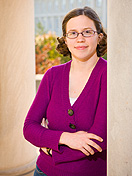News
Isoflavones decrease risk of invasive breast cancer, large tumors
-
 Print
Print -
 Comments
Comments
-

“Overall, this study indicates that isoflavone intake may be associated with tumor characteristics with more favorable prognoses.”
Isoflavones, chemicals found in soy products and in small amounts in other plant-based foods, may be associated with a reduced risk of developing certain types of breast tumors, a new study by researchers at UB and Roswell Park Cancer Institute (RPCI) has found.
The study showed that women with newly diagnosed breast cancer who consumed the highest versus lowest amounts of isoflavones, a class of phytoestrogens, had a 30-percent decreased risk of having an invasive tumor—one that had spread into the breast tissue instead of remaining in the epithelial layer of cells—and a 60-percent decreased risk of having a grade 1 tumor.
Tumor grade refers to the similarity of cancer cells to normal cells. As cancer progresses, the cells become more abnormal and increase in grade (1, 2, 3). The study also found a potential decreased breast cancer risk associated with specific isoflavones.
Anne Weaver, an epidemiology PhD student in the Department of Social and Preventive Medicine, UB School of Public Health and Health Professions, is first author on the study. She presented the findings at the American Association for Cancer Research International Conference—Frontiers in Cancer Prevention held recently in Philadelphia.
“Countries with high isoflavone intake tend to have lower breast cancer rates,” Weaver says. “Previous studies have had mixed results, but they indicate that isoflavone intake may be related with a reduced risk of breast cancer. This study examined isoflavone intake in relation to several different tumor characteristics.
“We believe that isoflavone intake may affect characteristics of breast cancer in different ways, so we examined several characteristics of breast cancer, including tumor size, stage, grade and hormone receptor status,” Weaver notes. Higher stage and grade indicate more severe cancers, while hormone-receptor status determines how likely a tumor is to respond to hormone-based treatments.
The researchers compared the amount of isoflavones eaten by women without cancer to the amount of isoflavones eaten by women with different breast cancer characteristics.
The study involved 683 women with newly diagnosed breast cancer and 611 women without a history of breast cancer, all of whom were enrolled in RPCI’s Data Bank and BioRepository. All women completed a questionnaire providing biographic and dietary information. Data on tumor characteristics of the women with cancer was retrieved from their medical records.
In addition to findings on isoflavones in general, results of the analysis showed a slight to moderate decrease in cancer risk and tumor characteristics in women in the highest third of specific dietary isoflavones.
The isoflavone glycetein showed the most relationships with breast-tumor characteristics. In the highest versus lowest third, glycetein was associated with an approximately 25-percent decreased odds of having cancer, 60-percent decreased odds of having a grade 1 tumor and 30-percent decreased odds of having a HER2 negative tumor.
HER2 is a human epidural growth-factor receptor, one of the hormone receptors, along with estrogen and progesterone receptors, that commonly are used to diagnose breast cancer. “Generally, HER2 positive tumors are more aggressive, while HER2 negative tumors are less aggressive,” Weaver explains.
In postmenopausal women only, results showed that cases in the highest-third intake versus lowest-third intake of the isoflavone glycetein had an approximately 30-percent decreased odds of having luminal A, or stage I, disease. The isoflavone genistein was associated with approximately 60-percent decreased odds of having a grade 1 tumor.
In premenopausal women only, highest total isoflavone intake, as well as intakes of isoflavones daidzein, genistein and glycetein, were associated with an approximately 70-percent decreased odds of having a large (greater than 2 cm) tumor. In addition, premenopausal women in the highest- versus lowest-third of total isoflavones and genistein intake had an approximately 60-percent lower risk of having stage II breast cancer.
“Results showed that premenopausal women with larger tumors were less likely to have eaten high amounts of isoflavones, compared to premenopausal women without cancer,” Weaver notes.
“Overall, this study indicates that isoflavone intake may be associated with tumor characteristics with more favorable prognoses,” she stresses. “However, our sample had low isoflavone intake compared to, for example, an Asian population. Most isoflavone intake was from other foods, so we can’t comment specifically on soy.”
The results were not conclusive, Weaver points out, so further studies need to be done to determine the mechanisms by which isoflavones may affect tumor characteristics.
Susan McCann of RPCI is senior author on the study. Additional contributors from RPCI are Katie Hootman, formerly a Department of Social and Preventive Medicine student at UB; Christine Ambrosone; Helena Hwang; and Carl Morrison. Peter Horvath from UB also is a contributor.
The research is funded by grants to McCann from the National Cancer Institute.

Reader Comments